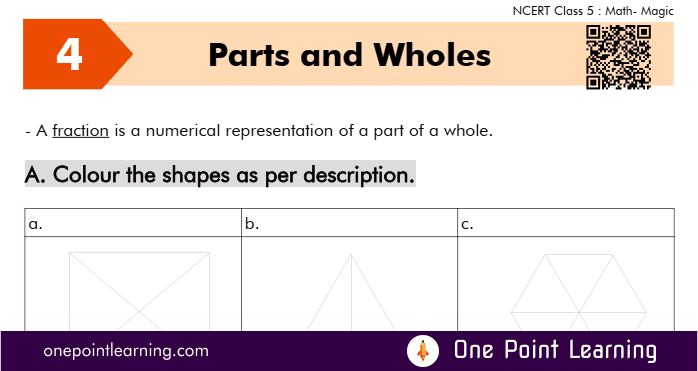NCERT Class 5 Maths Chapter 4 Parts and Wholes, introduces the concept of fractions and wholes in a practical way with real life examples.
The chapter begins with the definition of a whole as something that can be divided into smaller parts. It then discusses different ways to divide whole shapes into equal parts, such as halves, thirds, quarters, and so on. It also introduces the concept of equivalent fractions, that represent the same amount of a whole.
Further, the chapter help students to master the concept of fractions with some real examples of using fractions in cooking, shopping, etc.
Our Class 5 Maths Chapter 4 worksheet with answer contains various question types to help students learn about fractions and wholes in an interactive way.
Class 5 Maths Chapter 4 Worksheet

Check also NCERT Class 5 Maths Worksheets with Answers for all chapters.
Moreover, you can also download our NCERT Solutions for Class 5 Maths in PDF covering all the questions given in the Math-Magic textbook.
Also Download:
NCERT Class 5 EVS Worksheets
NCERT Hindi Worksheet for Class 5
Understanding Chapter 4 Parts and Wholes
The chapter on “Parts and Wholes” in Class 5 mathematics is a crucial part of the lesson, as it sets the stage for students to learn about fractions.
In our daily life, we often deal with objects or quantities that can be divided into smaller parts called fractions. Conversely, we can combine these small parts to form a whole.
e.g. cutting a pizza into slices or sharing candies among friends. These day-to-day activities involve dividing a whole into equal parts.
Moreover, fractions are used in cooking recipes (using 1/2 cup of flour), measuring ingredients (pouring 3/4 litre of water), and understanding discounts (saving 25% on a purchase).
Objectives of the Chapter 4 Parts and Wholes
- The learning objectives for this chapter includes:
- Understanding what fractions are and how they are represented.
- Differentiating between different types of fractions, like proper and improper fractions.
- Learning how to compare, add, subtract, multiply, and divide fractions.
- Applying fractions to solve practical problems in daily life.
Definition of Fractions:
A fraction is a numerical representation of a part of a whole.
It consists of two main components:
Numerator: The numerator is the top number in a fraction. It represents the number of equal parts or items you have.
Denominator: The denominator is the bottom number in a fraction. It represents the total number of equal parts or items that make up a whole.
Types of Fractions:
Proper Fractions:
A proper fraction is a fraction where the numerator is less than the denominator.
Example: 3/7 (Three parts out of seven)
Improper Fractions:
An improper fraction is a fraction where the numerator is equal to or greater than the denominator.
Example: 7/4 (Seven parts out of four, which can be simplified)
Mixed Numbers:
A mixed number is a combination of a whole number and a proper fraction.
Example: 2 1/3 (Two whole units and one-third of another unit)
Operations with Fractions:
Fractions can be operated upon using various mathematical operations:
Adding and Subtracting Fractions: Add or subtract the numerators if the denominators are the same. If not, find a common denominator first.
Multiplying Fractions: Multiply the numerators and denominators separately.
Dividing Fractions: Multiply the first fraction by the reciprocal of the second fraction (flip the second fraction).

Practical application of fractions in real-life situations
Sharing and Dividing:
Fractions are applied in sharing items among people equally, such as dividing a pizza or sharing a bag of candies.
Cooking and Baking:
Recipes often use fractions to specify ingredient quantities. e.g. a recipe might call for 1/2 cup of sugar, 3/4 teaspoon of salt, or 1/4 pound of butter.
Measurement:
When measuring quantities, fractions are essential. For example, when measuring liquids in a measuring cup e.g. 1/2 cup
Financial Transactions:
Fractions are used in financial transactions, such as calculating discounts, interest rates, and percentages. 20% discount
Sport and Fitness:
In sports and fitness, fractions are used to calculate distances, time intervals, and percentages of improvement. 15% work done or 1/3 time
Advantages of Class 5 Maths Chapter 4 worksheet PDF
- NCERT Maths Worksheet for Class 5 helps students to get clear understanding of topics
- Free Maths Worksheets are designed by subject experts as per NCERT syllabus
- Printable Maths worksheets covers various questions types for complete practice
- Maths worksheets for class 5 are easy to download and print at home
- All the worksheets includes answer key with the best possible solution



